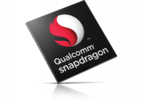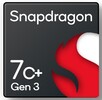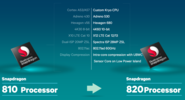Qualcomm Snapdragon 821 MSM8996 Pro vs Qualcomm Snapdragon 7c+ Gen 3 vs Qualcomm Snapdragon 820 MSM8996
Qualcomm Snapdragon 821 MSM8996 Pro
► remove from comparison
The Qualcomm Snapdragon 821 MSM8996 is a high-end ARM-based SoC largely found on Android tablets and smartphones. Announced in mid 2016, the S820 is the successor to the Snapdragon 820 and from a technical perspective a higher clocked version of the SoC. In addition to 4 CPU cores (two slower clocked and two faster clocked Kryo cores), the SoC integrates an Adreno 530 GPU with a LPDDR4 memory controller and supports Wi-Fi (802.11ad + MIMO), Bluetooth 4.1, and LTE.
CPU
The Snapdragon 821 is based on a similar concept as ARM's big.LITTLE, which combines a low power CPU cluster (2x Kyro clocked at up to 1.6 GHz?) and a performance CPU cluster (2x Kyro clocked at up to 2.4 GHz). The clock speed of each cluster can be individually adjusted (but not per core) and the lowest clock speed is 310 MHz. The performance cluster features 1 MB L2 cache and the power saving one 512 KB. Both should be using the same architecture and fully support the ARMv8-ISA instruction set.
Although only four cores are used, the performance of the 821 is located in the high end of mobile CPUs for smartphones and tablets. The performance advantage of the 821 compared to the 820 depends on the used clock speed. E.g. in the Google Pixel, the SoC is only clocked at 2.15 GHz and therefore identical to many 820 SoCs.
GPU
The Adreno 530 outperforms the previous Adreno 430 especially in high demanding benchmarks. Therefore it is well suited of modern 3D games on Android devices and should rank slightly below the Tegra X1 GPU. Compared to the 530 in the 820, the 821 version should be up to 5 % faster, which speaks for a slightly higher clock speed.
Features
The Snapdragon 821 offers numerous wireless technologies such as Bluetooth 4.1, WLAN 802.11a/b/g/n/ac/ad (60 GHz) + MIMO as well as a dual-SIM cellular modem supporting LTE cat. 12/13 .
The SoC can encode and decode 4K videos using dedicated hardware (H.264 and H.265).
Power Consumption
Thanks to the new 14 nm process, the energy efficiency has been improved noticeably compared to its 20 nm predecessors.
Qualcomm Snapdragon 7c+ Gen 3
► remove from comparison
The Snapdragon 7c+ Gen 3 is a rather slow ARM chip for very inexpensive Chromebooks and Windows laptops that was announced in December 2021. Very few systems powered by this chip seem to actually have made it to shelves. The 14-inch Galaxy Book2 Go 5G is one such laptop.
While the iGPU model that the 7c Plus Gen 3 comes equipped with isn't disclosed, we do know that its 8 CPU cores are spread across 2 clusters. The first one is comprised of A55 cores running at 1.5 GHz. The second one is home to faster A76 cores running at 2.4 GHz.
Architecture and Features
The Snapdragon SoC features LPDDR4x and LPDDR5 memory support (up to 6,400 MT/s). The only laptop equipped with this chip that seems to be available for purchase in September 2024 has just 4 GB of RAM which probably runs in a single channel (technically, dual channel) configuration. 64-bit x86 code emulation is supported natively which is very important for app compatibility.
Wi-Fi 6 and 6E are onboard, including the 6 GHz band and 160 MHz channel width support. So are Bluetooth 5.2 and 5G, 4G LTE, 3G, CDMA courtesy of the Snapdragon X53 5G modem which was quite an achievement back in 2021. The highest USB version supported is 3.1 Gen 1 (5 Gbit/s).
As far as storage is concerned, a system built around the 7c+ Gen 3 should be compatible with PCIe NVMe SSDs [it is likely that two PCIe 3 lanes or 4 PCIe 2 lanes are on offer for peak throughput of around 2 GB/s], as well as with UFS 3.1, eMMC 5.1 and SD 3.0 compliant storage solutions.
It goes without saying that this chip gets permanently soldered onto the motherboard. It's not user-upgradeable.
Performance
The Qualcomm CPU delivers performance resemblant of lower-end ULV Intel chips such as the Pentium N6000 when executing multi-threaded x86 code. Even in 2021, this would just about be good enough for basic day-to-day activities. For 2024, this is a very poor result.
Graphics
The unknown Adreno series iGPU that the SoC comes with delivers very unimpressive performance on par with Intel's 24 EU iGPU found on a couple of Jasper Lake chips. Qualcomm states that display resolutions no higher than FHD+ are supported; that means the classic FHD resolution (1920 x 1080 pixels) is certainly covered.
Power consumption
Since this is a low-performance part that is built with a still relevant 6 nm process, it is likely to consume very little power. 5 W or 6 W under load is probably a reasonable figure to name. No fan is needed to dissipate this little heat.
Qualcomm Snapdragon 820 MSM8996
► remove from comparison
The Qualcomm Snapdragon 820 MSM8996 is a high-end ARM-based SoC largely found on Android tablets and smartphones. Announced in December 2015, the S820 is the successor to the Snapdragon 810 and should start shipping in the first half of 2016. In addition to 4 CPU cores (two slower clocked and two faster clocked Kryo cores), the SoC integrates an Adreno 530 GPU with a LPDDR4 memory controller and supports Wi-Fi (802.11ad + MIMO), Bluetooth 4.1, and LTE.
CPU
The Snapdragon 820 is based on a similar concept as ARM's big.LITTLE, which combines a low power CPU cluster (2x Kyro clocked at up to 1.6 GHz) and a performance CPU cluster (2x Kyro clocked at up to 2.15 GHz). The clock speed of each cluster can be individually adjusted (but not per core) and the lowest clock speed is 310 MHz. The performance cluster features 1.5 MB L2 cache and the power saving one 512 KB. Both should be using the same architecture and fully support the ARMv8-ISA instruction set.
Although only four cores are used, the performance of the 820 is located in the high end of mobile CPUs for smartphones and tablets.
GPU
The Adreno 530 outperforms the previous Adreno 430 especially in high demanding benchmarks. Therefore it is well suited of modern 3D games on Android devices and should rank slightly below the Tegra X1 GPU.
Features
The Snapdragon 820 offers numerous wireless technologies such as Bluetooth 4.1, WLAN 802.11a/b/g/n/ac/ad (60 GHz) + MIMO as well as a dual-SIM cellular modem supporting LTE cat. 12/13 .
The SoC can encode and decode 4K videos using dedicated hardware (H.264 and H.265).
Power Consumption
Thanks to the new 14 nm process, the energy efficiency has been improved noticeably compared to its 20 nm predecessors.
| Model | Qualcomm Snapdragon 821 MSM8996 Pro | Qualcomm Snapdragon 7c+ Gen 3 | Qualcomm Snapdragon 820 MSM8996 | ||||||||||||||||||||||||||||||||||||
| Codename | Kryo | Kryo | Kryo | ||||||||||||||||||||||||||||||||||||
| Series | Qualcomm Snapdragon | Qualcomm Snapdragon | Qualcomm Snapdragon | ||||||||||||||||||||||||||||||||||||
| Series: Snapdragon Kryo |
|
|
| ||||||||||||||||||||||||||||||||||||
| Clock | 2400 MHz | 2400 MHz | 2200 MHz | ||||||||||||||||||||||||||||||||||||
| L1 Cache | 256 KB | ||||||||||||||||||||||||||||||||||||||
| L2 Cache | 1.5 MB | 1.5 MB | |||||||||||||||||||||||||||||||||||||
| Cores / Threads | 4 / 4 | 8 4 x 2.4 GHz ARM Cortex-A78 4 x 1.5 GHz ARM Cortex-A55 | 4 / 4 | ||||||||||||||||||||||||||||||||||||
| Technology | 14 nm | 6 nm | 14 nm | ||||||||||||||||||||||||||||||||||||
| Features | Adreno 530, LTE Hexagon 680 DSP, UMTS, GSM, WCDMA, Dual-SIM, eMMC 5.0, UHS-I, 802.11a/b/g/n/ac (2.4/5 GHz) + MIMO, Bluetooth 4.1, USB 3.0, Dual-Channel LPDDR4 Memory Controller | Adreno 530, LTE Hexagon 680 DSP, UMTS, GSM, WCDMA, Dual-SIM, eMMC 5.0, UHS-I, 802.11a/b/g/n/ac (2.4/5 GHz) + MIMO, Bluetooth 4.1, USB 3.0, Dual-Channel LPDDR4 Memory Controller | |||||||||||||||||||||||||||||||||||||
| iGPU | Qualcomm Adreno 530 ( - 653 MHz) | Qualcomm Adreno 642L | Qualcomm Adreno 530 ( - 624 MHz) | ||||||||||||||||||||||||||||||||||||
| Architecture | ARM | ARM | ARM | ||||||||||||||||||||||||||||||||||||
| Announced | |||||||||||||||||||||||||||||||||||||||
| Manufacturer | www.qualcomm.com | www.qualcomm.com | www.qualcomm.com |
Benchmarks
Average Benchmarks Qualcomm Snapdragon 821 MSM8996 Pro → 100% n=3
Average Benchmarks Qualcomm Snapdragon 7c+ Gen 3 → 250% n=3
Average Benchmarks Qualcomm Snapdragon 820 MSM8996 → 91% n=3
* Smaller numbers mean a higher performance
1 This benchmark is not used for the average calculation












